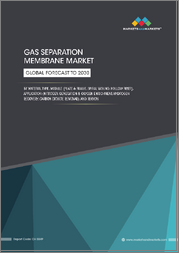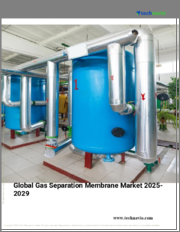
|
시장보고서
상품코드
1616342
가스 분리막 시장 기회, 성장 촉진요인, 산업 동향 분석, 예측(2024-2032년)Gas Separation Membrane Market Opportunity, Growth Drivers, Industry Trend Analysis, and Forecast 2024 - 2032 |
||||||
세계의 가스 분리막 시장 규모는 2023년에 12억 달러
예측에 따르면 2024-2032년 CAGR은 6.5%입니다. 이 산업은 높은 투과성과 선택성, 열 및 화학적 안정성이 우수한 폴리이미드와 폴리아미드를 주로 가스 분리막에 사용합니다. 이들 폴리머는 고온 및 가혹한 화학 물질과 같은 가혹한 조건에도 견딜 수 있으며, 수소 회수, 이산화탄소 제거, 질소 생성 등의 용도에 적합합니다. 질소와 산소의 분리 수요가 급증하면서 가스 분리막 산업이 성장하고 있습니다. 제약, 식품 및 음료, 화학, 전자 등의 분야에서 고순도 질소와 산소에 대한 수요가 증가하고 있습니다.
이러한 가스는 불활성 가스 블랭킷에서 의료용 산소 공급에 이르기까지 다양한 용도로 사용됩니다. 가스 분리막은 비용 효율적이고 에너지 효율적인 솔루션으로 등장하여 산업계가 현장에서 가스를 생산할 수 있게 함으로써 기존의 벌크 가스 공급을 피할 수 있게 해줍니다. 산업 공정이 진화하고 지속가능성에 대한 관심이 높아지면서 멤브레인 기반 가스 분리 시스템에 대한 수요가 증가하여 시장 성장을 주도하고 있습니다. 산업은 재료 유형, 모듈, 용도 및 지역으로 분류됩니다.
재료 유형별 시장 세분화에는 폴리이미드 및 폴리아미드, 셀룰로오스 아세테이트, 폴리설폰 및 기타가 포함되며, 2023년 폴리이미드 및 폴리아미드 시장 규모는 5억 5,000만 달러로 2032년에는 9억 8,000만 달러에 달할 것으로 예상됩니다. 폴리이미드와 폴리아미드의 장점은 우수한 열 안정성, 기계적 강도 및 가스 분리에 대한 높은 선택성에 기인합니다. 이러한 특성으로 인해 질소, 산소, 이산화탄소와 같은 가스를 분리하는 산업 용도에서 특히 효과적입니다. 모듈별 시장 세분화에는 중공사, 나선형 권선, 플레이트 및 프레임, 기타 등이 포함됩니다.
| 시장 범위 | |
|---|---|
| 개시년 | 2023년 |
| 예측년 | 2024-2032년 |
| 개시 가격 | 12억 달러 |
| 예상 가격 | 20억 7,000만 달러 |
| CAGR | 6.5% |
중공사는 2023년에 52%의 시장 점유율을 차지하며 2032년까지 큰 성장이 전망됩니다. 중공사막이 가스 분리 시장을 선도하고 있는 것은 높은 표면적 대 부피비, 컴팩트한 시스템에서 효율적인 가스 분리가 가능하기 때문입니다. 중공사막의 설계는 비용 효율적으로 확장할 수 있으며, 다른 막 유형보다 더 작은 설치 공간에서 더 많은 양의 가스를 처리할 수 있으며, 2023년 아시아태평양이 가스 분리막 세계 시장을 주도하여 4억 1,000만 달러의 매출을 기록했습니다. 이 지역의 우위는 급속한 산업화, 급성장하는 제조업, 에너지 수요 증가에 힘입은 바 큽니다. 석유화학, 제약, 식품 및 음료 등 주요 산업은 이 지역의 가스 분리 기술 소비의 주요 원동력이 되고 있습니다.
목차
제1장 조사 방법과 조사 범위
제2장 개요
제3장 산업 인사이트
- 에코시스템 분석
- 주요 제조업체
- 유통업체
- 산업 전체의 이익률
- 산업에 대한 영향요인
- 촉진요인
- 시장이 해결해야 할 과제
- 시장 기회
- 새로운 기회
- 성장 가능성 분석
- 원료 상황
- 제조 동향
- 기술의 진화
- 지속가능 제조
- 그린 프랙티스
- 탈탄소화
- 지속가능 제조
- 원료의 지속가능성
- 원료 가격 동향(달러/킬로톤)
- 북미
- 유럽
- 아시아태평양
- 중동 및 아프리카
- 라틴아메리카
- 규제와 시장에 대한 영향
- Porter의 산업 분석
- PESTEL 분석
제4장 경쟁 구도
- 기업 점유율 분석
- 경쟁 포지셔닝 매트릭스
- 전략 전망 매트릭스
제5장 시장 규모·예측 : 재료 유형별, 2021-2032년
- 주요 동향
- 폴리이미드 & 폴리아라미드
- 아세트산 셀룰로오스
- 폴리설폰
- 기타
제6장 시장 규모·예측 : 모듈별, 2021-2032년
- 주요 동향
- 중공사
- Spiral wound
- 플레이트 & 프레임
- 기타
제7장 시장 규모·예측 : 용도별, 2021-2032년
- 주요 동향
- 질소 생성·산소 부화
- 수소 회수
- 이산화탄소 제거
- 증기/가스 분리
- 공기 탈수
- H2S 제거
- 기타
제8장 시장 규모·예측 : 지역별, 2021-2032년
- 주요 동향
- 북미
- 미국
- 캐나다
- 유럽
- 독일
- 영국
- 프랑스
- 이탈리아
- 스페인
- 기타 유럽
- 아시아태평양
- 중국
- 인도
- 일본
- 한국
- 호주
- 기타 아시아태평양
- 라틴아메리카
- 브라질
- 멕시코
- 아르헨티나
- 기타 라틴아메리카
- 중동 및 아프리카
- 사우디아라비아
- 아랍에미리트
- 남아프리카공화국
- 기타 중동 및 아프리카
제9장 기업 개요
- Air Liquide
- Air Products and Chemicals, Inc.
- DIC Corporation
- FUJIFILM Manufacturing Europe B.V.
- Generon
- Honeywell UOP
- Membrane Technology and Research Inc.
- PARKER HANNIFIN CORPORATION
- SLB
- UBE Corporation
The Global Gas Separation Membrane Market was valued at USD 1.2 billion in 2023. Projections indicate a CAGR of 6.5% from 2024 to 2032. The industry predominantly utilizes polyimide and polyaramide materials for gas separation membranes, thanks to their remarkable thermal and chemical stability, coupled with high permeability and selectivity. These polymers can endure extreme conditions, such as elevated temperatures and harsh chemicals, making them apt for applications including hydrogen recovery, carbon dioxide removal, and nitrogen generation. The surging demand for nitrogen and oxygen separation propels the gas separation membrane industry. Sectors like pharmaceuticals, food and beverage, chemicals, and electronics increasingly seek high-purity nitrogen and oxygen.
These gases serve diverse purposes, from inert gas blanketing to medical oxygen supply. Gas separation membranes emerge as a cost-effective and energy-efficient solution, enabling industries to generate gases on-site, sidestepping the need for traditional bulk gas deliveries. As industrial processes evolve and sustainability gains prominence, the appetite for membrane-based gas separation systems swells, driving market growth. The industry is segmented into material type, module, application, and region.
Market segmentation by material type includes polyimide & polyaramide, cellulose acetate, polysulfone, and others. In 2023, polyimide & polyaramide commanded a market value of USD 550 million, with projections reaching USD 980 million by 2032. Their dominance stems from superior thermal stability, mechanical strength, and heightened selectivity in gas separation. These attributes make them particularly effective in industrial applications for separating gases like nitrogen, oxygen, and carbon dioxide. Market segmentation by module includes hollow fiber, spiral wound, plate & frame, and others.
| Market Scope | |
|---|---|
| Start Year | 2023 |
| Forecast Year | 2024-2032 |
| Start Value | $1.2 Billion |
| Forecast Value | $2.07 Billion |
| CAGR | 6.5% |
Hollow fiber, holding a 52% market share in 2023, is anticipated to see significant growth by 2032. The hollow fiber membranes' lead in the gas separation market is attributed to their high surface-area-to-volume ratio, facilitating efficient gas separation in compact systems. Their design allows for cost-effective scalability, processing large gas volumes in a more compact footprint than alternative membrane types. In 2023, the Asia Pacific led the global gas separation membrane market, generating revenues of USD 410 million. The region's dominance is fueled by swift industrialization, a burgeoning manufacturing sector, and escalating energy demands.Key industries, including petrochemicals, pharmaceuticals, and food and beverage, drive the region's substantial consumption of gas separation technologies.
Table of Contents
Chapter 1 Methodology & Scope
- 1.1 Market scope & definition
- 1.2 Base estimates & calculations
- 1.3 Forecast calculation
- 1.4 Data sources
- 1.4.1 Primary
- 1.4.2 Secondary
- 1.4.2.1 Paid sources
- 1.4.2.2 Public sources
Chapter 2 Executive Summary
- 2.1 Industry 360° synopsis
Chapter 3 Industry Insights
- 3.1 Industry ecosystem analysis
- 3.1.1 Key manufacturers
- 3.1.2 Distributors
- 3.1.3 Profit margins across the industry
- 3.2 Industry impact forces
- 3.2.1 Growth drivers
- 3.2.2 Market challenges
- 3.2.3 Market opportunity
- 3.2.3.1 New opportunities
- 3.2.3.2 Growth potential analysis
- 3.3 Raw material landscape
- 3.3.1 Manufacturing trends
- 3.3.2 Technology evolution
- 3.3.2.1 Sustainable manufacturing
- 3.3.2.1.1 Green practices
- 3.3.2.1.2 Decarbonization
- 3.3.2.1 Sustainable manufacturing
- 3.3.3 Sustainability in raw materials
- 3.3.4 Raw material pricing trends (USD/ Kilo Tons)
- 3.3.4.1 North America
- 3.3.4.2 Europe
- 3.3.4.3 Asia Pacific
- 3.3.4.4 Middle East and Africa
- 3.3.4.5 Latin America
- 3.4 Regulations & market impact
- 3.5 Porter's analysis
- 3.6 PESTEL analysis
Chapter 4 Competitive Landscape, 2023
- 4.1 Company market share analysis
- 4.2 Competitive positioning matrix
- 4.3 Strategic outlook matrix
Chapter 5 Market Size and Forecast, By Material Type, 2021-2032 (USD Billion, Kilo Tons)
- 5.1 Key trends
- 5.2 Polyimide & polyaramide
- 5.3 Cellulose acetate
- 5.4 Polysulfone
- 5.5 Others
Chapter 6 Market Size and Forecast, By Module, 2021-2032 (USD Billion, Kilo Tons)
- 6.1 Key trends
- 6.2 Hollow fiber
- 6.3 Spiral wound
- 6.4 Plate & frame
- 6.5 Others
Chapter 7 Market Size and Forecast, By Application, 2021-2032 (USD Billion, Kilo Tons)
- 7.1 Key trends
- 7.2 Nitrogen generation & oxygen enrichment
- 7.3 Hydrogen recovery
- 7.4 Carbon dioxide removal
- 7.5 Vapor/gas separation
- 7.6 Air dehydration
- 7.7 H2S removal
- 7.8 Others
Chapter 8 Market Size and Forecast, By Region, 2021-2032 (USD Billion, Kilo Tons)
- 8.1 Key trends
- 8.2 North America
- 8.2.1 U.S.
- 8.2.2 Canada
- 8.3 Europe
- 8.3.1 Germany
- 8.3.2 UK
- 8.3.3 France
- 8.3.4 Italy
- 8.3.5 Spain
- 8.3.6 Rest of Europe
- 8.4 Asia Pacific
- 8.4.1 China
- 8.4.2 India
- 8.4.3 Japan
- 8.4.4 South Korea
- 8.4.5 Australia
- 8.4.6 Rest of Asia Pacific
- 8.5 Latin America
- 8.5.1 Brazil
- 8.5.2 Mexico
- 8.5.3 Argentina
- 8.5.4 Rest of Latin America
- 8.6 MEA
- 8.6.1 Saudi Arabia
- 8.6.2 UAE
- 8.6.3 South Africa
- 8.6.4 Rest of MEA
Chapter 9 Company Profiles
- 9.1 Air Liquide
- 9.2 Air Products and Chemicals, Inc.
- 9.3 DIC Corporation
- 9.4 FUJIFILM Manufacturing Europe B.V.
- 9.5 Generon
- 9.6 Honeywell UOP
- 9.7 Membrane Technology and Research Inc.
- 9.8 PARKER HANNIFIN CORPORATION
- 9.9 SLB
- 9.10 UBE Corporation



















